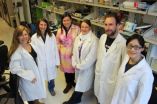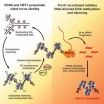(Press-News.org) ROCHESTER, Minn. — March 20, 2014 — Is irritable bowel syndrome (IBS) caused by genetics, diet, past trauma, anxiety? All are thought to play a role, but now, for the first time, researchers have reported a defined genetic defect that causes a subset of IBS. The research was published in the journal Gastroenterology.
Researchers estimate that approximately 15 to 20 percent of the Western world has IBS. It is a common disorder that affects the large intestine. Most patients with the disorder commonly experience symptoms of cramping, abdominal pain, bloating gas, diarrhea and constipation. Most treatments for IBS target these symptoms.
Researchers found that patients with a subset of IBS have a specific genetic defect, a mutation of the SCN5A gene. This defect causes patients to have a disruption in bowel function, by affecting the Nav1.5 channel, a sodium channel in the gastrointestinal smooth muscle and pacemaker cells.
The research is in early stages, but the results of this study give researchers hope of finding therapies for these patients.
"This gives us hope that from only treating symptoms of the disease, we can now work to find disease-modifying agents, which is where we really want to be to affect long-term treatment of IBS," says Gianrico Farrugia, M.D., a study author, Mayo Clinic gastroenterologist and director of the Mayo Clinic Center for Individualized Medicine.
Researchers studied the sodium channel of 584 people with IBS and 1,380 control subjects. The analysis demonstrated that a defect in the SCN5A gene was found in 2.2 percent of IBS patients. The results were confirmed in a genome-wide association study and replicated in 1,745 patients in four independent cohorts of patients with IBS and control subjects.
Additionally, researchers were able to restore function to a patient with constipation predominant IBS with a defective SCN5A gene and resulting abnormally functioning sodium channel. Researchers used a drug called mexiletine, which restored the function of the channel and reversed the patient's symptoms of constipation and abdominal pain.
This study also included researchers from the Karolinska Institutet in Stockholm, and others in Italy and Greece.
INFORMATION:
About Mayo Clinic
Recognizing 150 years of serving humanity in 2014, Mayo Clinic is a nonprofit worldwide leader in medical care, research and education for people from all walks of life. For more information, visit 150years.mayoclinic.org, http://www.mayoclinic.org and newsnetwork.mayoclinic.org.
MEDIA CONTACT:
Brian Kilen, Mayo Clinic Public Affairs, 507-284-5005, newsbureau@mayo.edu
Mayo Clinic researchers find genetic clue to irritable bowel syndrome
2014-03-20
ELSE PRESS RELEASES FROM THIS DATE:
Health insurance coverage increased ER use in Massachusetts
2014-03-20
WASHINGTON — The implementation of health care reform in Massachusetts – principally the expansion of health insurance coverage to nearly everyone in the state – was associated with a small but consistent increase in emergency department use, according to the findings of a study to be published online today in Annals of Emergency Medicine ("Increased Use of the Emergency Department After Health Care Reform in Massachusetts").
"This obviously has implications about what we can expect to see nationally as the roll-out of the Affordable Care Act continues," said Peter ...
Big government -- or good neighbors -- can improve people's health
2014-03-20
Lincoln, Neb., March 20, 2014 – The nation's left-leaning citizens might be pleased by the findings of a new University of Nebraska study that finds those who live in liberal states tend to be healthier.
But conservatives could also take satisfaction in the same study's conclusion that strong communities also foster better health.
"Some people might like the argument that liberal government automatically leads to healthier people, because it supports their worldview," said Mitchel Herian, a faculty fellow with the university's Public Policy Center and lead researcher ...
Plankton make scents for seabirds and a cooler planet
2014-03-20
The top predators of the Southern Ocean, far-ranging seabirds, are tied both to the health of the ocean ecosystem and to global climate regulation through a mutual relationship with phytoplankton, according to newly published work from the University of California, Davis.
When phytoplankton are eaten by grazing crustaceans called krill, they release a chemical signal that calls in krill-eating birds. At the same time, this chemical signal — dimethyl sulfide, or DMS — forms sulfur compounds in the atmosphere that promote cloud formation and help cool the planet. Seabirds ...
Wind farms can provide society a surplus of reliable clean energy, Stanford study finds
2014-03-20
The worldwide demand for solar and wind power continues to skyrocket. Since 2009, global solar photovoltaic installations have increased about 40 percent a year on average, and the installed capacity of wind turbines has doubled.
The dramatic growth of the wind and solar industries has led utilities to begin testing large-scale technologies capable of storing surplus clean electricity and delivering it on demand when sunlight and wind are in short supply.
Now a team of Stanford researchers has looked at the "energetic cost" of manufacturing batteries and other storage ...
Satellite confirms Tropical Cyclone Mike's quick disappearing act
2014-03-20
Tropical Cyclone Mike didn't even last a day in the Southern Pacific Ocean as NOAA's GOES-West satellite revealed the storm dissipating just 24 hours after it was born.
The Joint Typhoon Warning Center's second update on Tropical Cyclone Mike was its last. At 2100 UTC/5 p.m. EDT Mike was located near 24.3 south latitude and 157.9 west, about 618 nautical miles/711.1 miles/ 1,145 km southwest of Papeete, Tahiti. Maximum sustained winds were near 35 knots/40 mph/62 kph at that time.
All warnings for the Southern Cook Islands were cancelled and Mike was quickly weakening ...
Face it: Instagram pictures with faces are more popular
2014-03-20
Like them or not, there's more proof that selfies aren't going away any time soon. Georgia Institute of Technology and Yahoo Labs researchers looked at 1.1 million photos on Instagram and found that pictures with human faces are 38 percent more likely to receive likes than photos with no faces. They're also 32 percent more likely to attract comments. The study is one of the first to examine how photos with faces drive engagement on large-scale, image-sharing communities.
The researchers also found that the number of faces in the photo, their age or gender didn't make ...
NASA sees ex-Tropical Cyclone Gillian's remnants persist
2014-03-20
NASA's TRMM satellite continues to follow the remnants of former Tropical Cyclone Gillian as it moved from the Southern Pacific Ocean into the Southern Indian Ocean where it appears to be re-organizing.
The persistent remnants of tropical cyclone Gillian have moved westward over 2,700 km/1,674 miles since forming in the Gulf of Carpentaria on March 8, 2014.
Gillian's coherent remnants were located just to the southeast of the Indonesian island of Java when the Tropical Rainfall Measuring Mission or TRMM satellite flew overhead on March 20, 2014 at 0415 UTC/12:15 a.m. ...
Interpreting neuroimages: The technology and its limits
2014-03-20
Neuroimages play a growing role in biomedical research, medicine, and courtrooms, as well as in shaping our understanding of what it means to be human. But how helpful are they at answering complex questions such as: What is depression? Is a defendant lying? Do we have free will?
These are among the topics explored in Interpreting Neuroimages: An Introduction to the Technology and Its Limits, a special report of the Hastings Center Report. It is edited by Josephine Johnston, a research scholar and director of research, and Erik Parens, a senior research scholar, and ...
Proteins that control energy use necessary to form stem cells
2014-03-20
Proteins that regulate energy metabolism are essential for stem cell formation, University of Washington researchers find.
Two proteins that control how cells metabolize glucose play a key role in the formation of human stem cells, UW researchers report.
The findings advance scientists' understanding of stem cell development but also suggest that the proteins, which also play a role in the process that transforms normal cells into cancer stem cells, might also be targets for new cancer therapies, the researchers write.
The findings appear online in the journal Cell ...
Gene silencing instructions acquired through 'molecular memory' tags on chromatin
2014-03-20
BLOOMINGTON, Ind. -- Scientists at Indiana University have unlocked one of the mysteries of modern genetics: how acquired traits can be passed between generations in a process called epigenetic inheritance. The new work finds that cells don't know to silence some genes based on information hardwired into their DNA sequences, but recognize heritable chemical marks that are added to the genes. These chemical tags serve as a form of molecular memory, allowing cells to recognize the genes and remember to silence them again in each new generation.
The discovery made by a 12-member ...







